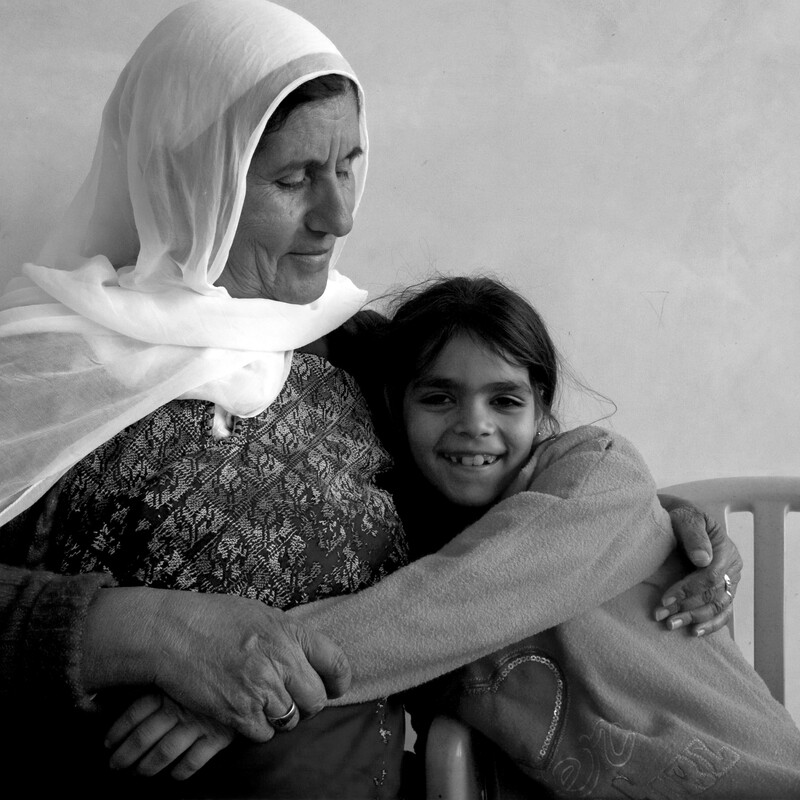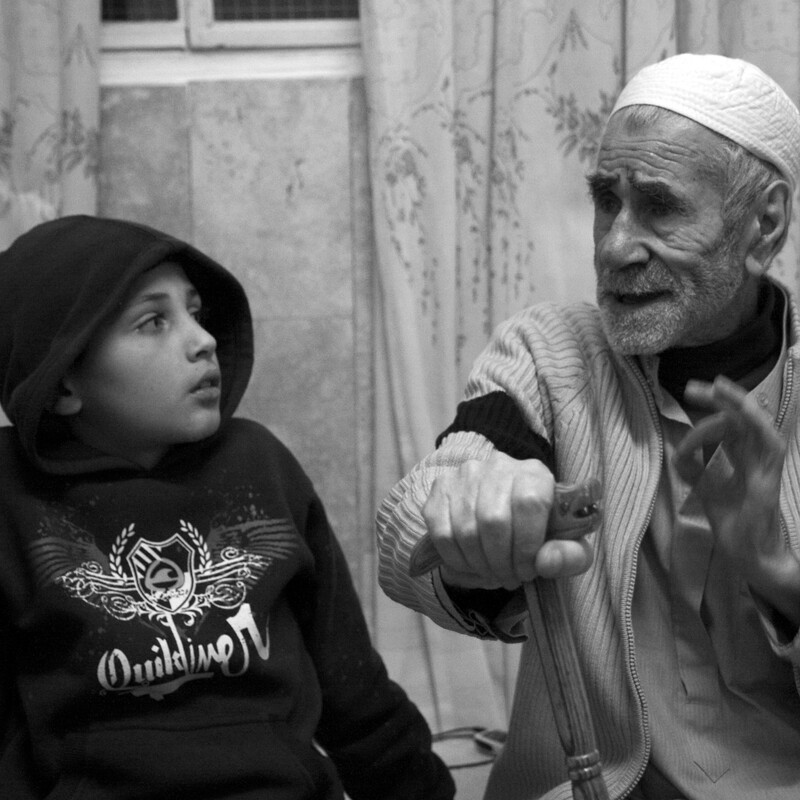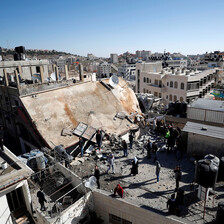The Electronic Intifada 27 June 2014

Wajeeda, 62-years-old, in Aida refugee camp, with a granddaughter.
There are more than five million Palestinian refugees registered with the United Nations, making up the largest group of refugees in the world. The Palestinian refugee advocacy group BADIL estimates there are an additional 2.7 million unregistered Palestinian refugees, making up 66 percent of the Palestinian population worldwide.
They have been waiting more than sixty years to exercise their right to return since their first mass forced displacement with the ethnic cleansing of Palestine by Zionist forces in 1948, what Palestinians call the Nakba or catastrophe, during the establishment of the State of Israel.
Five generations since then, many Palestinian refugees today live in poor conditions in crowded camps. The stateless are among the most vulnerable, as their plight in Syria continues to show.
With the conviction that the right of return is not a side issue but is at the core of the so-called conflict, this series depicts a Palestinian refugee child with a grandparent, a first-generation refugee. Through it I hope to emphasize not only the duration of the plight of Palestinian refugees, but also to visualize the extraordinary bond and solidarity that Palestinian refugees share across generations, preserving their dignity and determination during the long wait and fight for justice.
I first worked on this series in 2008 but I had left it buried and unfinished in my archive. Although I have worked for years in these camps and know how central the issue of Palestinian refugees are, I put it aside as there were always developments in Palestine that seemed more urgent.
This series questions the way the “conflict” is portrayed and how a core issue remains largely left out of the story, leaving the plight of millions of Palestinians in a perpetual state of uncertainty and invisibility.
As the first generation of refugees and the immediate survivors of the Nakba become fewer in number, it is more urgent than ever to bring their histories back to the center of the discourse on Palestine.
Wajeeda, the woman in the photo above, told me: ”I remember when we were under the tent [after the 1948 Nakba]. It was a very small tent for four persons but we were seven children there. There were only six toilets for hundreds of people. The life was very bad. I know that to return to the homeland is just a dream but I still hope for these children of the new generation to return.”
Anne Paq is a French freelance photographer and member of the photography collective ActiveStills.

Al-Amari refugee camp, near Ramallah. A major problem with most refugee camps is the severe overcrowding and lack of infrastructure. There are usually no sidewalks and no green space, only small walkways formed by rows and rows of concrete buildings.

Youssef, seven years old, lives in al-Aroub refugee camp near the West Bank city of Hebron. “I see the Israeli army every day in our camp when I come back from school,” he says. His 73-year-old grandfather Youssef says: “I felt humiliated and insulted when I was kicked out from my village. We left without our things in cars that Israelis brought to take us far away. We still hope to go back. If we are dead, our children will.”

Abed, ninety years old, lives in al-Aroub refugee camp: “I used to own a lot of land. I had animals, and trees. I want to go back there to die. I want to finish my life there.”

Mohammad, 83 years old, lives in al-Azzeh camp, the smallest in the West Bank and where the unemployment rate is high. “I cannot explain my feelings with one sentence,” he says. “Those who have no country have no dignity. I have no dignity. I always think of the past. Life was better then. We had our land. Now if you don’t work, you don’t eat. I feel angry. I was a fighter against the British and the Zionists. If I had the strength to fight, I will fight the Palestinian leaders.”

Israel’s wall in Aida refugee camp near the West Bank city of Bethlehem is built only a few meters away from the homes of the refugees and prevents them from accessing the olive grove where they used to go for recreation.

Approximately 40 percent of the Palestinian refugee population are children, according to a 2007 report by the refugee advocacy group BADIL. A 2012 survey by the group states that 27 percent of the population is under the age of 15.

Tasneem, nine years old, lives in al-Amari camp near the West Bank city of Ramallah “This place is not my place. I would like to go back to my original village and I pray for my father to get out of prison,” she says. Her 54-year-old grandmother Khadija has five sons, four of them in prison.

Mahmoud, eighteen years old, lives in Aida refugee camp near Bethlehem. “There is something missing in my life,” he says. Abed, his 75-year-old grandfather, says: “I feel miserable because my village is gone. I was fourteen years old when we had to leave our land. We had a small house and land. It was a simple life but we did not need any help from other people or institutions. I could go back once to Beit Jibrin, and when I saw that everything was destroyed I felt very sad.”

Ninety-year-old Fatima in al-Amari camp shows the original property documents from her home in Lod (al-Lydd). “I wish I had died there in my village,” she says. “It would have been better than living in this camp. The Zionists attacked us with weapons and threatened us. We ran away. We slept under trees with no food. I lost my twelve-year-old brother during the Nakba.”

Mahmoud, eleven years old, lives in Balata refugee camp near the West Bank city of Nablus. His father is in prison and his young brother was killed by the Israeli army in 2004 when he was four years old. Zuhdeia, his seventy-year-old grandmother, is a shop owner and has 57 grandchildren.

Nearly one-third of the registered Palestine refugees, more than 1.5 million individuals, live in 58 recognized Palestine refugee camps in Jordan, Lebanon, Syria, the Gaza Strip and the West Bank, including East Jerusalem, according to UNRWA, the UN agency for Palestine refugees.

Zakia, 85 years old, lives in Qalandia refugee camp near the West Bank city of Ramallah. “I feel the exile, the instability, the loss of my rights with the approval of all the world which let Israel take our lands,” she says.

Balata camp near the city of Nablus was established in 1950 and has become the largest West Bank camp in terms of inhabitants, with more than 23,000 registered refugees.

Ibrahim, 83 years old, lives in Dheisheh refugee camp near the West Bank city of Bethlehem: “I was around twenty years old and I had a wife and a son. Our family owned 1,000 dunums [a dunum is the equivalent of 1,000 square meters]. We had fifty goats, twenty-five cows, two camels and fifty hens. When the Israeli soldiers entered the Palestinian villages, they shot everywhere and we were afraid. When I heard that my friend and his wife were killed, I became even more afraid and I hid myself and my family in a well for one night. For two years we had been going from one place to another. Once I was able to return to my village, five years after we left. Everything was destroyed, including my home. I just found two dogs that I knew before and they recognized me. I was very sad when I saw all the destruction.”

Khadija, 75 years old, says: “I was fifteen years old when the Israelis came to Ras Abu Ammar. I was married, I had a house, thirty goats, one camel and hens. We owned twenty dunums. For two years we went to different places before Dheisheh camp. We live here like cats in this room and nobody cares about refugees.”

Hakma, 75 years old, lives in Dheisheh refugee camp: “I was seventeen years old, I was pregnant and had a two-month-old baby. When we heard about Deir Yassin [a massacre in a village near Jerusalem], we got afraid and left. One day in my original village equals one life in this camp.”

According to the Palestinian Central Bureau of Statistics, 31 percent of Palestinian refugees in the occupied West Bank and Gaza Strip live below the poverty line.

Ahmad, sixteen years old, lives in Aida refugee camp and wants to work as a DJ: “I am proud of being refugee but I hate where I live. I hope to return to my homeland.” His grandmother, 70 years old, says: “I was twelve years old when the soldiers arrived. My house was very beautiful and we grew many things on our land. There were a lot of shootings at the houses. I am a refugee and I got married under the tent, can you imagine? I want to say to the world: do not forget Palestine.”

Salma, seven years old, with Ahmad, her 76-year-old grandfather, in his shop in al-Azzeh camp near the West Bank city of Nablus. Ahmad says: “There is no humiliation in the world such as being away from your own village.”

Fatima, 67 years-old, surrounded by some of her grandchildren in Dheisheh refugee camp.





